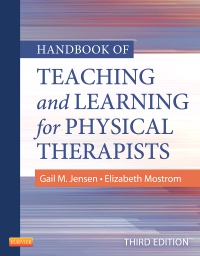
Handbook of Teaching and Learning for Physical Therapists, 3rd Edition
Paperback

Whether students will be practicing in an in-patient or an out-patient facility, academic institution, or clinical residency program, this well-respected handbook gives them the background and guidance they need to effectively educate individuals across the continuum of physical therapy practice. Practical, real-life examples show how to: incorporate health literacy and needs of the learner; assess and adapt to the various learning styles of patients; use simulations in education; facilitate the development of clinical reasoning skills; and assess learning outcomes and the effectiveness of the teaching. Plus, four all-new chapters and major revisions of all content throughout the book keep students on top of the latest research and best practices.
-
- NEW! Chapter on Authentic Assessment: Simulation-Based Education reflects the new ways to facilitate student learning through the use of human simulation models.
- NEW! Chapter on Strategies for Planning and Implementing Interprofessional Education covers the fundamental concepts of team-based care and interprofessional learning.
- NEW! Chapter on What Makes a Good Clinical Teacher? translates current research on clinical teaching into clinical education and practice.
- NEW! Chapter on Facilitating the Teaching and Learning of Clinical Reasoning helps students apply current research on clinical reasoning in rehabilitation to clinical education and teaching.
- NEW! Two combined chapters on Patient Education and Health Literacy (previously chapters 8 and 12) and Applied Behavioral Theory and Adherence: Models for Practice (previously chapters 9 and 10) provide focused presentations on current thinking and practical strategies for addressing health literacy issues in the clinical environment.
- NEW! Expanded chapter on Post-Professional Clinical Residency and Fellowship Education offers more information on models and trends in residency education and mentoring.
- Coverage of the theory and application of educational principles across the continuum of PT practice provides students and therapists with the information they need to improve their skills in the educational process whether they are in academic or clinical settings.
- Two section format divides content into two parts: designing academic and clinical education programs and teaching students in academic and clinical settings; and teaching patients and families in clinical and community settings.
- Variety of teaching and teaching assessment methods expands readers’ teaching, learning, and assessment repertoires.
- Case stories at the beginning of each chapter allow students to see the relevance of the information in the chapter.
- Threshold concepts highlight key ideas that are essential to the learner.
- Annotated bibliography at end of each chapter provides reader with resources for further study.
-
- NEW! Chapter on Authentic Assessment: Simulation-Based Education reflects the new ways to facilitate student learning through the use of human simulation models.
- NEW! Chapter on Strategies for Planning and Implementing Interprofessional Education covers the fundamental concepts of team-based care and interprofessional learning.
- NEW! Chapter on What Makes a Good Clinical Teacher? translates current research on clinical teaching into clinical education and practice.
- NEW! Chapter on Facilitating the Teaching and Learning of Clinical Reasoning helps you apply current research on clinical reasoning in rehabilitation to clinical education and teaching.
- NEW! Two combined chapters on Patient Education and Health Literacy (previously chapters 8 and 12) and Applied Behavioral Theory and Adherence: Models for Practice (previously chapters 9 and 10) provide focused presentations on current thinking and practical strategies for addressing health literacy issues in the clinical environment.
- NEW! Expanded chapter on Post-Professional Clinical Residency and Fellowship Education offers more information on models and trends in residency education and mentoring.
-
Section I: Education in the Academic Environment
- Curriculum Design for Physical Therapy Educational Programs
- From Curriculuar Goals to Instruction: Preparing to Teach
- Teaching and Learning in Academic Settings
- Physical Therapy Education in the Digital Age: Leveraging Technologies to Promote Learning
- Assessing and Improving the Teaching and Learning Process in Academic Settings
- Authentic Assessment: Simulation-Based Education NEW!
- Strategies for Planning and Implementing Interprofessional Education NEW!
- Preparation for Teaching in Clinical Settings
- Techniques for Teaching in Clinical Settings
- What Makes a Good Clinical Teacher? NEW!
- Facilitating the Teaching and Learning of Clinical Reasoning NEW!
- Patient Education and Health Literacy NEW!
- Applied Behavioral Theory and Adherence: Models for Practice NEW!
- Teaching and Learning Psychomotor Skills
- Community Health Promotion: Evolving Opportunities for Physical Therapists
- Post-Professional Clinical Residency and Fellowship Education
Section II: Education in Practice Environments

 as described in our
as described in our 